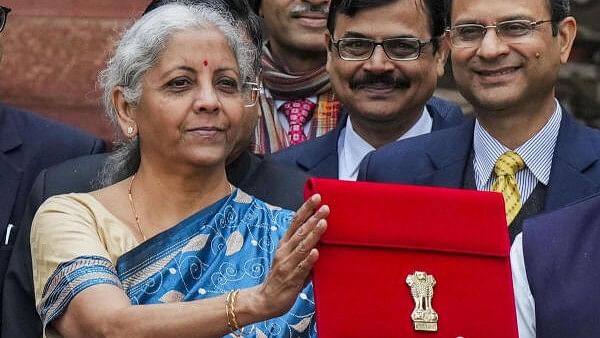
Union Finance Minister Nirmala Sitharaman will present the Union Budget for the fiscal year 2024-25 in the Lok Sabha on Tuesday morning.
Credit: PTI File Photo
Union Finance Minister Nirmala Sitharaman will present the Union Budget for the fiscal year 2024-25 in the Lok Sabha on Tuesday morning. Ahead of the budget, Sitharaman tabled the Economic Survey 2023-24 on Monday.
Preparing the budget for a country like India with more than 1.4 billion people belonging to different strata of life is a hefty task. The process takes months and involves various ministries including the Ministry of Finance and NITI Aayog.
We have sorted out five major steps from the lengthy and impeccable task for you to understand the process of budget preparation easily.
Issuance of circulars
Six months ahead of the presentation of the Union Budget, the ministry of finance issues 'Budget Circulars' to different ministries and departments of the central and state governments. These circulars lay down the instruction and guidelines that are to be followed while preparing the budget estimates. These circulars then reach both the disbursement officers and filed personnel who, in turn, provide a detailed breakdown of their department's finances. This breakdown mentions expenditure and income for both the current and previous fiscal years, along with their financial needs for the upcoming year.
Consultation on proposals
Data accumulated from the ground-level officers and the proposals made by them are sent to senior officials for scrutiny. After the audit, the officials decide whether the proposals can be approved or need to be scrutinised. The data is then sent to the concerned ministries and departments for another round of scrutiny before finally reaching the Ministry of Finance. The Finance Ministry then assesses the data with its own to determine whether the proposals are feasible and achievable based on the resources available at hand.
Allocation of revenue
After completing the audit process, the Ministry of Finance allocates resources to different ministries and also crafts public welfare schemes. During this process, if a dispute arises, the ministry resolves it by consulting the Prime Minister or the Union Cabinet. The decision of the Prime Minister is considered final in such cases. Once the allocation process is done, the Finance Ministry works along with the Central Board of Direct Taxes and the Central Board of Excise and Customs to prepare reports. These reports outline the estimated revenue in the upcoming fiscal year and a detailed budget report is carved out of it.
Halwa ceremony
The 'halwa ceremony' marks the beginning of the printing of the budget after the document is finalised. Halwa is distributed among the members of the ministry and the Union Finance Minister also takes part in the ceremony. After the ceremony, a 'lock-in' period begins for all the officials involved in the preparation of the budget. To maintain utmost secrecy, the officials are confined to the ministry premises and cut-off from the outside world till the budget is officially presented by the finance minister.
Presentation of Union Budget
In this final stage of the whole process, the finance minister presents the Union Budget in front of the Parliament. Traditionally, the budget is presented on February 1, however in election years an interim budget can be presented before the new government comes up with the final budget. This year too, Finance Minister Nirmala Sitharaman presented an interim budget on February 1. The Union Budget 2024 will be presented on July 23 in the Lok Sabha.
Union Budget 2024 | Making a record for any Finance Minister, Nirmala Sitharaman will be presenting her 7th Union Budget on July 23, 2024 under the Modi 3.0 government. While inflation has burnt a hole in the pockets of 'aam janata', will this Budget spell relief for Indians? Track the latest coverage, live news, in-depth opinions, and analysis only on Deccan Herald. Also follow us on WhatsApp, LinkedIn, X, Facebook, YouTube, and Instagram.